28 February, 2000
Torres del Paine National Park Wildlife
Question 9: What are the large flightless birds of the other southern
continents?
After nearly a century of sheep farming on the land, the vegetation is slow
to recover. The native animals and birds are now protected here, and many of
the populations are growing after nearly 20 years without hunting. The most
outstanding wildlife conservation success story of the park is the guanaco
(Lama guanicoe), the area's wild llama relative. They graze in herds on the
open steppe. Patagonian steppe is dry, windswept brushy grassland habitat and
is more common on the eastern side of the park. There were no guanacos in the
wooded or lush green areas of the park.
The guanaco herds we saw ranged in size from a few animals to 100+. Usually
there was a loosely dispersed herd of around 10. There are little guanacos at
this time of year, much flightier than their parents, but very cute! The
adult guanacos would look up when we stopped and occasionally put their ears
back. Otherwise, they didn't pay too much attention to us. Many of them took
dust baths by rolling in dried-up marsh or pond pans. They have extremely
long eyelashes and a facial expression that looks like a surprised smile.
Their coat is fine, but shorter than that of the semi-domesticated alpaca
which is used in native textiles.
The Chilean deer or huemul is much rarer, but still exists in the park. We
saw neither them nor the puma, the only large predator in the area. The other
predators are two species of fox and a small wild cat. They prey principally
upon the introduced European hare.
Native birds are doing well within the park. The largest and most impressive
is the Andean Condor, similar to our Californian Condor. They have a wingspan
of over three meters and are usually seen soaring far overhead taking
advantage of warm updrafts of air. They are scavengers and must land to eat
and rest, but their large size makes take-off an ordeal. A pair lays only one
egg every two years because of the long period of time it takes to raise the
chick. A condor swooped over the hill we were standing on, passing within 20
feet of us. Truly incredible!
The other large bird, much more common than the condor, is the Lesser Rhea
(locally called the Nandu), a flightless ostrich-like bird that inhabits the
grassland and steppe along with the guanacos and sheep estancias. They are
about a meter tall and have three toes and long legs for running. They graze
in pairs, but are omnivorous, eating insects if available. The only ones we
saw in larger groups were young birds with their father. The female lays
anywhere from 12-25 eggs in a nest, but once they hatch the father takes care
of them. The males may also steal young from neighbors' broods, so one male
can end up shepherding a large group of young of many different ages.
Our group split up today, some going hiking up to the torres, some fishing,
some taking pictures, and some birdwatching (me!). It didn't rain on us, but
it was very windy with strong gusts that snap the car doors back. Since
birding is more flexible, I was the designated chauffeur, dropping off and
picking up members of our group. I also filled the car with gas at the park's
central administration, the only "gas station" inside the park or within 100
km of it. They used a funnel made out of a hose section and a liter soda
bottle to get the gas into the tank. Then the guy filling it up ran back and
forth with gallon milk jugs full of diesel fuel. We picked up our hikers and
had dinner at the hosteria at the base of the mountain, then had a long drive
back around Lake Sarmiento to the hosteria where we were staying on Green Lake
(Lago Verde).
Answer 8: Sedimentary rock.
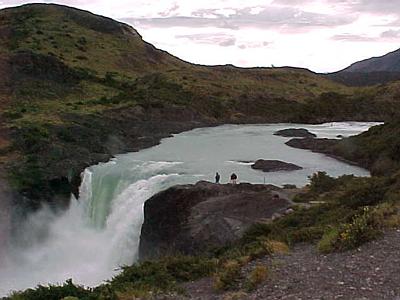
Saltos Grande (Large waterfall) going from Lago Nordenskj=F6ld to Lago Peho= =E9.
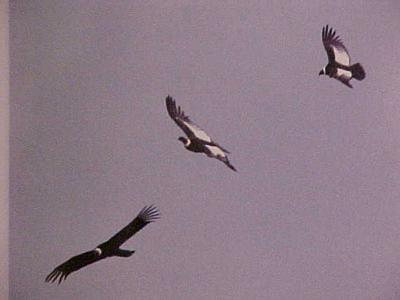
Andean Condors

Part of a Guanaco herd.
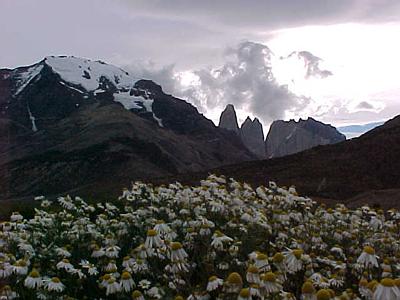
Torres del Paine

Gas station in the park.
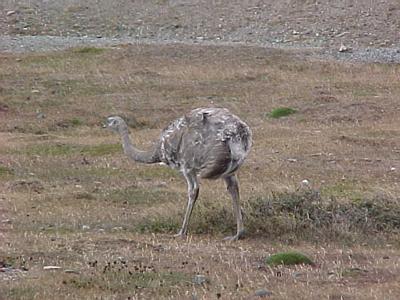
Lesser Rhea
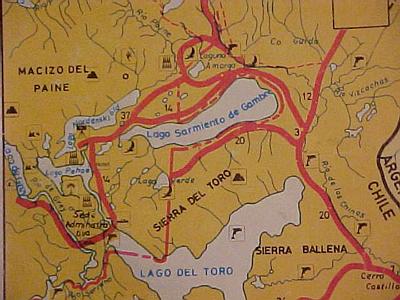
Map of the main park area.
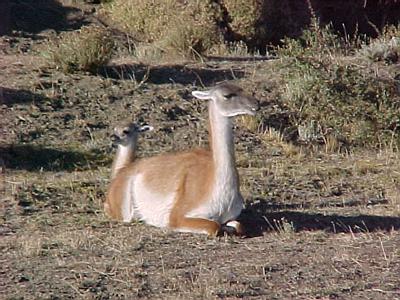
Mama Guanaco and baby.

Contact the TEA in the field at
.
If you cannot connect through your browser, copy the
TEA's e-mail address in the "To:" line of
your favorite e-mail package.
|
